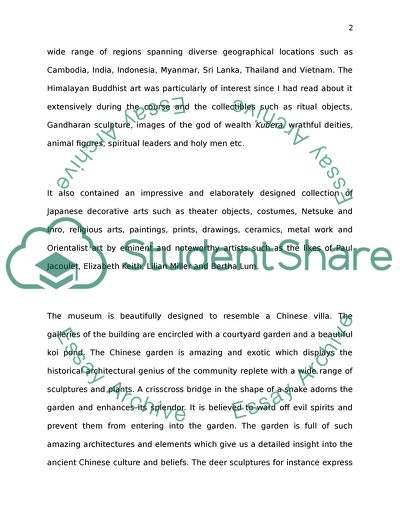
- Home
- Free Samples
- Premium Essays
- Editing Services
- Extra Tools
- Essay Writing Help
- About Us
- Studentshare
- Subjects
- Miscellaneous
- Pacific asia Museum
Pacific asia Museum - Essay Example

- Subject: Miscellaneous
- Type: Essay
- Level: Undergraduate
- Pages: 4 (1000 words)
- Downloads: 0
- Author: waelchilane
Extract of sample "Pacific asia Museum"
ccessfully played host to an impressively large and diverse audience ranging from school children, to university students, adults, families, scholars, art historians etc. The Pacific Asia Museum has an outstanding collection of various artifacts of historical significance which includes Chinese Decorative Arts such as Jade Vessels and ritual objects, jade and soapstone carvings, Buddhist sculpture, wood, stone and bronze treasures, and paintings; Chinese ceramics which includes tomb treasures, porcelains for the palace, and other miscellaneous items of ceramic.
The South East Asian Art section contained artifacts from wide range of regions spanning diverse geographical locations such as Cambodia, India, Indonesia, Myanmar, Sri Lanka, Thailand and Vietnam. The Himalayan Buddhist art was particularly of interest since I had read about it extensively during the course and the collectibles such as ritual objects, Gandharan sculpture, images of the god of wealth Kubera, wrathful deities, animal figures, spiritual leaders and holy men etc. It also contained an impressive and elaborately designed collection of Japanese decorative arts such as theater objects, costumes, Netsuke and Inro, religious arts, paintings, prints, drawings, ceramics, metal work and Orientalist art by eminent and noteworthy artists such as the likes of Paul Jacoulet, Elizabeth Keith, Lilian Miller and Bertha Lum.
The museum is beautifully designed to resemble a Chinese villa. The galleries of the building are encircled with a courtyard garden and a beautiful koi pond. The Chinese garden is amazing and exotic which displays the historical architectural genius of the community replete with a wide range of sculptures and plants. A crisscross bridge in the shape of a snake adorns the garden and enhances its splendor. It is believed to ward off evil spirits and prevent them from entering into the garden. The garden is full of such amazing architectures and elements which give us a detailed insight
...Download file to see next pages Read MoreCHECK THESE SAMPLES OF Pacific asia Museum
Origins of Modern Museum
Coventry Museum - From Denial to Discovery
How Museums Institutions Shape the Art World
Development of My Interest in Business Economics
Pacific Asian Art: The Interactions of Dynastic Cultures
Origins of Modern Museum
Analysis of One of the Largest Museums of the US - Art Museum Philadelphia
Arts Management

- TERMS & CONDITIONS
- PRIVACY POLICY
- COOKIES POLICY